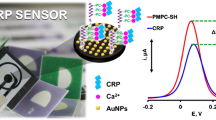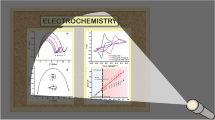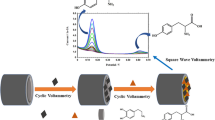Abstract
The authors describe an electrochemical sensor for nitrite that is based on the use of a screen printed carbon electrode modified with palladium nanoparticles and an amino-functionalized metal-organic framework. The morphology and properties of the resulting material were examined by X-ray photoelectron spectroscopy, X-ray diffraction, thermogravimetry, FTIR spectroscopy and transmission electron microscopy. Nitrite was chosen as a model analyte to evaluate the electron transfer performance of the modified SPCE. Its preparation conditions were optimized. The response to nitrite was studied via cyclic voltammetry, linear sweep voltammetry, and square wave voltammetry. Under the optimal conditions, the oxidation current (typically measured at −0.86 V vs Ag/AgCl) increases linearly in the 5 to 150 nM nitrite concentration range, and the detection limit is 1.3 nM. The sensor was applied to the detection of nitrite in (spiked) sausage and pickle samples. It is highly selective to nitrite in the presence of high concentrations of other electro-active compounds, stable, and well reproducible. In our perception, the sensor presented here reveals the large potential of MOF-based hybrid materials for use as an electrode material.

A screen printed electrode (SPCE) modified with a metal organic framework of the type Pd/NH2-MIL-101(Cr) is found to be ultra-sensitive for nitrite detection with excellent stability, high selectivity, acceptable repeatability and reproducibility. The sensor is designed specifically to detect nitrite in sausage and pickle samples with an excellent detection limit of 1.3 nM.





Similar content being viewed by others
References
Wang C, Liu X, Demir NK, Chen JP, Li K (2016) Applications of water stable metal–organic frameworks. Chem Soc Rev 45:5107
Horcajada P, Chalati T, Serre C, Gillet B, Sebrie C, Baati T, Eubank JF, Heurtaux D, Clayette P, Kreuz C (2010) Porous metal-organic-framework nanoscale carriers as a potential platform for drug delivery and imaging. Nat Mater 9:172
Chen L, Chen H, Luque R, Li Y (2014) Metal-organic framework encapsulated Pd nanoparticles: towards advanced heterogeneous catalysts. Chem Sci 5:3708
Yang J, Yang L, Ye H, Zhao F, Zeng B (2016) Highly dispersed AuPd alloy nanoparticles immobilized on UiO-66-NH2 metal-organic framework for the detection of nitrite. Electrochim Acta 219:647–654
Carson F, Pascanu V, Bermejo Gómez A, Zhang Y, Platero-Prats AE, Zou X, Martín-Matute B (2015) Influence of the base on Pd@ MIL-101-NH2 (Cr) as catalyst for the Suzuki–Miyaura cross-coupling reaction. Chem Eur J 21:10896
Cheng D, Li X, Qiu Y, Chen Q, Zhou J, Yang Y, Xie Z, Liu P, Cai W, Zhang C (2017) A simple modified electrode based on MIL-53 (Fe) for the highly sensitive detection of hydrogen peroxide and nitrite. Anal Methods 9:2082
Kumar RS, Kumar SS, Kulandainathan MA (2012) Highly selective electrochemical reduction of carbon dioxide using Cu based metal organic framework as an electrocatalyst. Electrochem Commun 25:70
Vilian ATE, Puthiaraj P, Kwak CH, Hwang SK, Huh YS, Ahn WS, Han YK (2016) Fabrication of palladium nanoparticles on porous aromatic frameworks as a sensing platform to detect vanillin. ACS Appl Mater Interfaces 8:12740
da Silva CTP, Veregue FR, Aguiar LW, Meneguin JG, Moisés MP, Fávaro SL, Radovanovic E, Girotto EM, Rinaldi AW (2016) AuNp@ MOF composite as electrochemical material for determination of bisphenol A and its oxidation behavior study. New J Chem 40:8872
Yadav DK, Ganesan V, Sonkar PK, Gupta R, Rastogi PK (2016) Electrochemical investigation of gold nanoparticles incorporated zinc based metal-organic framework for selective recognition of nitrite and nitrobenzene. Electrochim Acta 200:276
Ikhsan NI, Rameshkumar P, Pandikumar A, Shahid MM, Huang NM, Kumar SV, Lim HN (2015) Facile synthesis of graphene oxide–silver nanocomposite and its modified electrode for enhanced electrochemical detection of nitrite ions. Talanta 144:908
Zuo J, Zhang Z, Jiao J, Pang H, Zhang D, Ma H (2016) Sensitive and selective nitrite sensor based on phosphovanadomolybdates H6[PMo9V3O40], poly (3, 4-ethylenedioxythiophene) and Au nanoparticles. Sensors Actuators B 236:418
Rastogi PK, Ganesan V, Krishnamoorthi S (2014) A promising electrochemical sensing platform based on a silver nanoparticles decorated copolymer for sensitive nitrite determination. J Mater Chem A 2:933
Amin D, Saleem K, Bashir W (1982) Titrimetric determination of chloramine-T and some aldoses by amplification reactions. Talanta 29:694
Hassan SS, Marzouk SA, Sayour HE (2003) Selective potentiometric determination of nitrite ion using a novel (4-sulphophenylazo-) 1-naphthylamine membrane sensor. Talanta 59:1237
Lin Z, Dou X, Li H, Ma Y, Lin JM (2015) Nitrite sensing based on the carbon dots-enhanced chemiluminescence from peroxynitrous acid and carbonate. Talanta 132:457
Frenzel W, Schulz-Brüssel J, Zinvirt B (2004) Characterisation of a gas-diffusion membrane-based optical flow-through sensor exemplified by the determination of nitrite. Talanta 64:278
Zhang D, Fang Y, Miao Z, Ma M, Du X, Takahashi S, Ji A, Chen Q (2013) Direct electrodeposion of reduced graphene oxide and dendritic copper nanoclusters on glassy carbon electrode for electrochemical detection of nitrite. Electrochim Acta 107:656
Chen P, McCreery RL (1996) Control of electron transfer kinetics at glassy carbon electrodes by specific surface modification. Anal Chem 68:3958–3965
Wen M, Mori K, Kamegawa T, Yamashita H (2014) Amine-functionalized MIL-101 (Cr) with imbedded platinum nanoparticles as a durable photocatalyst for hydrogen production from water. Chem Commun 50:11645
Saikia M, Saikia L (2016) Palladium nanoparticles immobilized on an amine-functionalized MIL-101 (Cr) as a highly active catalyst for oxidative amination of aldehydes. RSC Adv 6:14937–14947
Luan Y, Yang M, Ma Q, Qi Y, Gao H, Wu Z, Wang G (2016) Introduction of an organic acid phase changing material into metal–organic frameworks and the study of its thermal properties. J Mater Chem A 4:7641–7649
Guidelli R, Pergola F, Raspi G (1972) Voltammetric behavior of nitrite ion on platinum in neutral and weakly acidic media. Anal Chem 44:745–755
Wang J, Hui N (2017) A nanocomposite consisting of flower-like cobalt nanostructures, graphene oxide and polypyrrole for amperometric sensing of nitrite. Microchim Acta 184:2411
Huang SS, Liu L, Mei LP, Zhou JY, Guo FY, Wang AJ, Feng JJ (2016) Electrochemical sensor for nitrite using a glassy carbon electrode modified with gold-copper nanochain networks. Microchim Acta 183:791
Wang J, Zhou H, Fan D, Zhao D, Xu C (2015) A glassy carbon electrode modified with nanoporous PdFe alloy for highly sensitive continuous determination of nitrite. Microchim Acta 182:1055
Wang G, Han R, Feng X, Li Y, Lin J, Luo X (2017) A glassy carbon electrode modified with poly (3, 4-ethylenedioxythiophene) doped with nano-sized hydroxyapatite for amperometric determination of nitrite. Microchim Acta 184:1721
Wu W, Li Y, Jin J, Wu H, Wang S, Ding Y, Ou J (2016) Sensing nitrite with a glassy carbon electrode modified with a three-dimensional network consisting of Ni7S6 and multi-walled carbon nanotubes. Microchim Acta 183:3159
Zhang F, Yuan Y, Zheng Y, Wang H, Liu T, Hou S (2017) A glassy carbon electrode modified with gold nanoparticle-encapsulated graphene oxide hollow microspheres for voltammetric sensing of nitrite. Microchim Acta 184:1565
Acknowledgements
The authors are grateful for the Basic Science Research Program through the National Research Foundation of Korea (NRF) funded by the Ministry of Science, ICT & Future Planning (2016R1A2B4013374, 2017M2A2A6A01020938, and 2014R1A5A1009799), Bose Dinesh gratefully acknowledge the DST-SERB for a National Postdoctoral Fellowship (PDF/2015/000174).
Author information
Authors and Affiliations
Corresponding authors
Ethics declarations
The author(s) declare that they have no competing interests.
Electronic supplementary material
ESM 1
(DOC 5247 kb)
Rights and permissions
About this article
Cite this article
Ezhil Vilian, A.T., Dinesh, B., Muruganantham, R. et al. A screen printed carbon electrode modified with an amino-functionalized metal organic framework of type MIL-101(Cr) and with palladium nanoparticles for voltammetric sensing of nitrite. Microchim Acta 184, 4793–4801 (2017). https://doi.org/10.1007/s00604-017-2513-8
Received:
Accepted:
Published:
Issue Date:
DOI: https://doi.org/10.1007/s00604-017-2513-8




